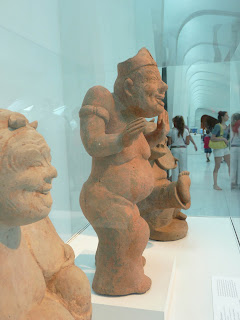China in Milwaukee

The world of the aging Qianlong Emperor,
shown above,
is the focus of this current exhibit
at the Milwaukee Museum of Art.
Back in the summer of 2004
the Field Museum
introduced us to the young emperor
who has become something of an icon
for a country
that is finally returning
to the strength and prosperity of his era
by reversing the cash flow
that once went out
to buy British and American opium,
and now is coming back
with the sale of consumer goods.
But as you can see
whatever optimism the emperor
had as a young man
has definitely disappeared over time.
And though he is recognized
as one of the greatest art collectors
of all time,
he liked to deface his favorite paintings
with his own enormous chop.
...not just once,
but using different chops
he smothered the scroll.
(most of those shown above are his)
My theory is that he stamped the scroll
every time he unrolled it,
but a local brush painting teacher
believes that he covered the scroll
with his stamp to prevent anyone else
from leaving their mark
in the centuries that followed.
This insane rootwood furniture
was the highlight
as far as I was concerned
It's not really rootwood,
it's just carved to imitate
its wild abandon
while still holding
to a sense of design.
It's something like rococo,
but feels less light hearted.
I suppose it exemplifies
natural forces under human control,
but that control seems fiendishly difficult.
No wonder it was locked away
in dark, unswept rooms
for 200 years.
One of his many thrones,
this one was on the top floor
of the tallest pavillion

This series of panels
depicting some rather coarse
Buddhist saints is based on a rubbing
from a carving that was taken
from a copy of a painting
that the emperor saw
on one of his trips to the south.
I don't really share
the emperor's enthusiasm
for it.
The largest figure in this shrine
is the emperor himself
depicted as the righteous
wheel-turning-king.
Above him, is his guru, Rolpy Dorje
the reincarnation of the highest priest
of the Mongolian Tibetan Buddhists.
The two of them were classmates
in prince school.
At the top is Tsongkhapa ( 1357-1419),
the founder of the Yellow-Hat sect
to which the Dali Lama belongs.
The Manchu emperors and the Yellow Hat lamas
recognized each others respective authority
in temporal and spiritual affairs.

This is a detail
from a charming trompe l'oeil mural
that depicts the imperial family
celebrating New Year.

Here's an example
of the emperor's calligraphy.
It's strong and elegant,
though not especially inspired.
Here's something by his son, the Jiaqing Emperor.
It feels as bloated as he was.
Just outside the Qianlong gallery,
is the
James Conley collection of Han Dynasty
tomb sculpture.
I'm especially fond
of these entertainers
These Laurel and Hardy figurines
from our era
seem a bit stiff and formal
by comparison.



This hallway in the new museum
is so enjoyable.









The wonderfully goofy Han Dynasty!
In what other time and place
could the "Romance of the Three Kingdoms"
have taken place?




These are roof decorations
from the Ming Dynasty






